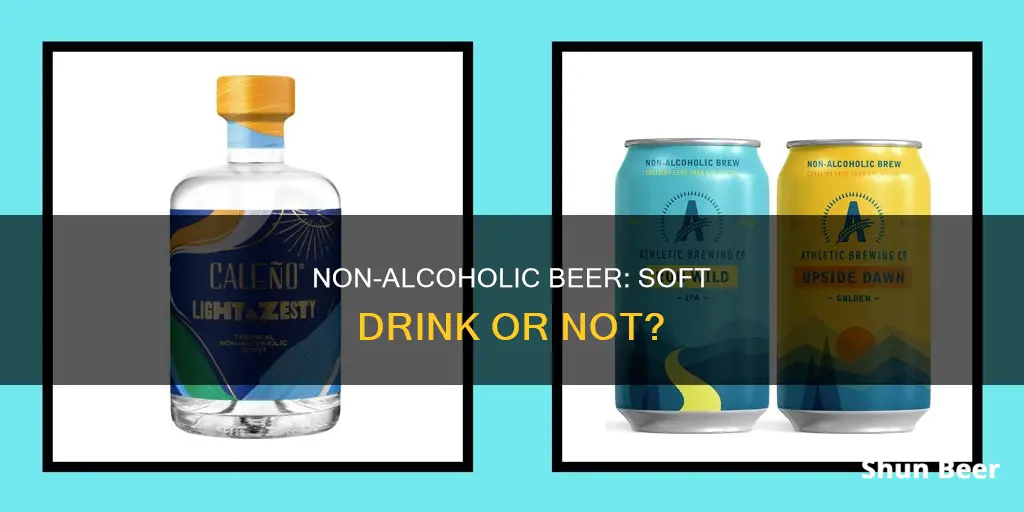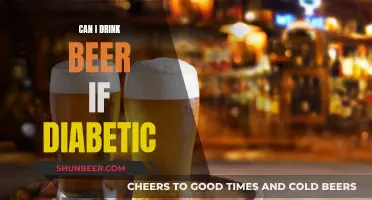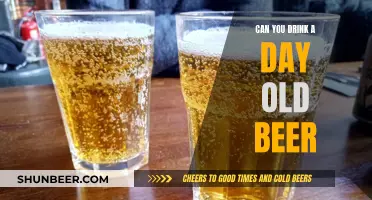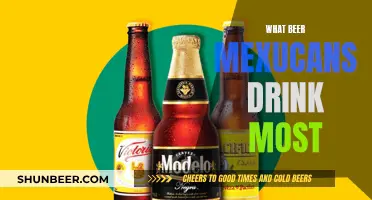
Non-alcoholic beer has become increasingly popular in recent years, with many people turning to it as a healthier alternative to regular beer. But is it a soft drink? The short answer is no. While non-alcoholic beer contains little to no alcohol, it is produced using traditional beer ingredients and methods, giving it a similar taste and appearance to regular beer. On the other hand, soft drinks are typically carbonated beverages with added sweeteners and flavours, designed for refreshment and widely consumed by all ages. This article will explore the key differences between non-alcoholic beer and soft drinks, and why they are classified separately.
| Characteristics | Values |
|---|---|
| Alcohol content | Non-alcoholic beer typically contains less than 0.5% ABV, while soft drinks may contain up to 0.5% ABV to be considered non-alcoholic. |
| Ingredients | Non-alcoholic beer is made using traditional beer ingredients like water, malt, hops, and yeast. Soft drinks are typically water-based and flavoured with natural or artificial ingredients, sweeteners, and carbonation. |
| Brewing process | Non-alcoholic beer undergoes a typical brewing process and then has the alcohol removed through heating or filtering. Soft drinks do not undergo a brewing process and are often carbonated. |
| Target audience | Non-alcoholic beer is targeted towards those who want the taste of beer without the effects of alcohol, such as those with religious or health restrictions or those who need to drive. Soft drinks are widely consumed by people of all ages and are primarily for refreshment. |
| Purpose | Non-alcoholic beer serves as an alternative for those who want to avoid the intoxicating effects of alcohol. Soft drinks are typically consumed for refreshment and are often sweet and carbonated. |
| Availability | Non-alcoholic beer is available where alcoholic drinks are sold. Soft drinks are widely available in various containers and at numerous locations, including fast-food restaurants, convenience stores, vending machines, etc. |
What You'll Learn

Non-alcoholic beer is not classed as a soft drink
Soft drinks are sweet, carbonated beverages typically made for refreshment and widely consumed by people of all ages. They are usually water-based and flavoured with natural or artificial ingredients, and often contain sweeteners, caffeine, colourings, preservatives, and other ingredients.
On the other hand, non-alcoholic beer is produced by removing or limiting the alcohol content of regular beer to less than 0.5% alcohol by volume. It is made using traditional beer ingredients like water, malt, hops, and yeast, and undergoes a typical brewing process. While it resembles beer in taste and appearance, its alcohol content is negligible, similar to some fruit juices.
The main difference lies in their purpose and target audience. Non-alcoholic beer is made for those who want the taste of beer without the effects of alcohol, such as for religious or health reasons, or as a safer option when driving. Soft drinks, on the other hand, are primarily consumed for refreshment and are marketed towards a wider range of consumers, including children.
Additionally, the methods of production, history, cultural significance, and marketing of non-alcoholic beer and soft drinks differ significantly. Non-alcoholic beer is often positioned as an alternative to regular beer, while soft drinks occupy a separate category in the beverage industry.
Beer and Nasal Congestion: What's the Link?
You may want to see also

Soft drinks are widely consumed by all ages
Soft drinks are indeed widely consumed by people of all ages. In the United States, 52% of 18-29-year-old consumers drink soft drinks, and 55% of 30-49-year-old consumers do the same. In 53 low- and middle-income countries, young adolescents aged 12-15 reported consuming carbonated soft drinks 1.39 times per day, with 54.3% of them drinking soft drinks at least once per day. This is particularly concerning given that soft drinks are a leading source of added sugars in Western diets and are linked to an increased risk of obesity, dental caries, early puberty, and aggressive behaviours among children and adolescents.
The consumption of soft drinks is not limited to younger age groups. In Europe, data from 2014 shows that a notable percentage of young people aged 11, 13, and 15 drink soft drinks at least once a day. While the exact percentages vary by country and age group, the fact that data is available for these age groups indicates that soft drink consumption is prevalent across a wide range of ages.
The rise of Islam and the increasing number of states where alcohol is prohibited have also contributed to the growing consumption of soft drinks. Soft drinks are often seen as a refreshing alternative to alcoholic beverages and are widely consumed during hot weather. Additionally, soft drinks are usually sweet and carbonated, making them appealing to a wide range of consumers, including those who prefer sweeter tastes or are looking for a refreshing beverage.
The widespread consumption of soft drinks by people of all ages has led to concerns about health and well-being. As a result, interventions and policies have been proposed to reduce soft drink consumption, especially among children and adolescents. These include public awareness campaigns, taxation, regulations on marketing targeting minors, reduced availability in schools, and front-of-pack labelling of manufactured foods with added sugars.
Drinking Beer on Siesta Key Beach: What's Allowed?
You may want to see also

Non-alcoholic beer is made using traditional beer ingredients
The basic ingredients for non-alcoholic beer are the same as those for regular beer, with some combination of water, yeast, malt, and hops. However, non-alcoholic beer undergoes additional steps to remove the alcohol.
There are several methods for creating a non-alcoholic beer. One method involves interfering with yeast during the fermentation process, inhibiting the creation of alcohol. Another method is dealcoholization, where heat or reverse osmosis is used to eliminate alcohol after the beer is made.
While non-alcoholic beer may not get you drunk, it is not entirely alcohol-free. Most non-alcoholic beers contain trace amounts of alcohol, usually less than 0.5% alcohol by volume. This is because it is challenging to remove all alcohol from beer, and some alcohol may still be present even after dealcoholization.
The process of making non-alcoholic beer ensures that it retains the flavour of traditional beer while reducing the alcohol content. This makes it a popular choice for those who want to enjoy the taste of beer without the intoxicating effects.
Mixing Beer and Wine: Safe or Not?
You may want to see also

Soft drinks are primarily for refreshment
The term "soft drink" is used in contrast with "hard" alcoholic drinks, and it generally refers to non-alcoholic beverages. Soft drinks are often viewed as refreshing alternatives to alcoholic drinks, especially in situations where abstinence from alcohol is necessary or preferred, such as driving, health concerns, or religious beliefs.
Non-alcoholic beer, on the other hand, is produced by removing or limiting the alcohol content in regular beer, typically to less than 0.5% alcohol by volume. While it resembles beer in taste and appearance, it is not considered a soft drink due to differences in production methods, ingredients, and target audience.
Non-alcoholic beer is specifically designed for those who want to enjoy the taste of beer without experiencing the effects of alcohol. It may be preferred by individuals with religious or health restrictions or those who want to avoid intoxication while driving. The brewing process and ingredients used in non-alcoholic beer differ from those of traditional soft drinks, giving it a distinct character.
Soft drinks, on the other hand, are typically sweet and carbonated, made primarily for refreshment and enjoyed by a wide range of consumers. They are often associated with carbonated beverages like soda or cola, which are commonly consumed as refreshing options during hot weather or alongside meals.
In summary, while both non-alcoholic beer and soft drinks share the characteristic of being non-intoxicating, they serve different purposes and cater to diverse consumer preferences. Soft drinks are primarily designed for refreshment and are enjoyed by a broad audience, while non-alcoholic beer is tailored to those seeking a beer-like experience without the alcohol content.
Fireball and Beer: A Safe Mix?
You may want to see also

Non-alcoholic beer is not recommended for children
Secondly, non-alcoholic beer is not a typical soft drink. Soft drinks are usually carbonated beverages with sweeteners, flavours, or caffeine, primarily consumed for refreshment. They are widely consumed by people of all ages. On the other hand, non-alcoholic beer is targeted at those who want the taste of beer without the intoxicating effects. It is produced using traditional beer ingredients and undergoes a brewing process similar to regular beer. This association with alcoholic beverages and the taste profile, which resembles beer, can give children the impression that drinking beer is acceptable and desirable.
Additionally, a study from Japan found that adolescents who consumed non-alcoholic beverages that mimicked alcohol showed greater interest in consuming alcohol. This suggests that early exposure to non-alcoholic beer could influence children's attitudes towards alcohol and potentially increase their risk of alcohol consumption and abuse in the future. It is important to note that the legal drinking age is typically set at 21 to save lives and prevent motor vehicle deaths and other adverse effects of alcohol consumption among minors.
Finally, allowing children to drink non-alcoholic beer can send mixed messages about alcohol consumption. While non-alcoholic beer is often chosen for positive reasons, such as religious beliefs or health reasons, it still contains traces of alcohol and is produced using similar ingredients and processes as regular beer. This can create a blurred line between alcoholic and non-alcoholic drinks, making it challenging to establish clear boundaries and set a consistent example for children. Therefore, it is recommended to encourage children to consume age-appropriate beverages and establish healthy habits from a young age.
Skydiving Soon? Pre-Flight Beer: Yay or Nay?
You may want to see also
Frequently asked questions
No, non-alcoholic beer is not considered a soft drink. Soft drinks are typically carbonated beverages with added sweeteners and flavours, while non-alcoholic beer is produced by removing or limiting the alcohol content of regular beer. The brewing process, ingredients, and purpose of non-alcoholic beer differ from traditional soft drinks.
Soft drinks are typically water-based, flavoured drinks that are carbonated and may contain sweeteners, caffeine, colourings, preservatives, and other ingredients. Non-alcoholic beer, on the other hand, is made using traditional beer ingredients like water, malt, hops, and yeast, and undergoes a typical brewing process before being heated or filtered to remove most of the alcohol content.
While both non-alcoholic beer and soft drinks may not have intoxicating effects, they are produced for different reasons and target different audiences. Soft drinks are primarily consumed for refreshment, while non-alcoholic beer is aimed at those who want the taste of beer without the effects of alcohol, such as for religious or health reasons, or when driving. Additionally, the methods of production, history, cultural significance, and marketing differ between the two types of beverages.







